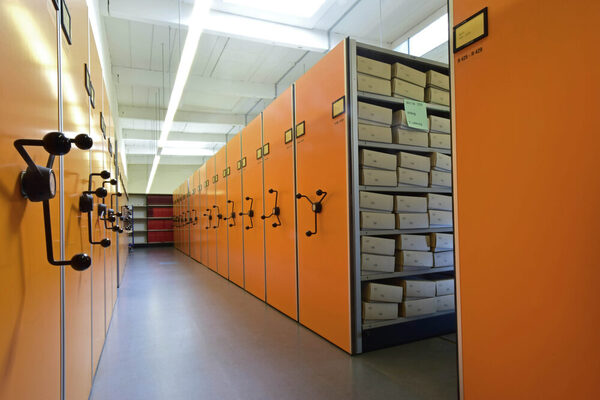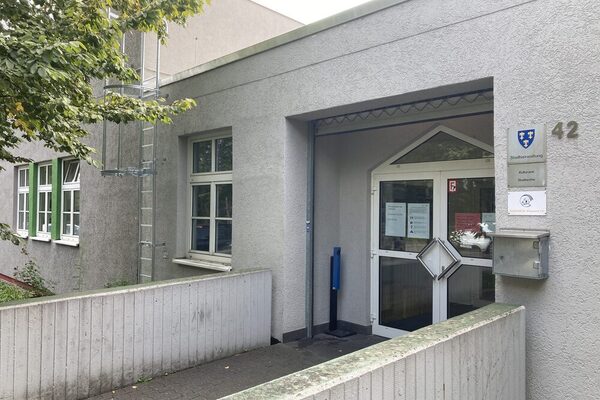City Archive Wiesbaden
The beginnings of the Wiesbaden city archive are shrouded in mystery. Its history is initially characterized by serious losses of documents: a large part of the city's documents fell victim to the city fire of 1547. After looting by soldiers during the Thirty Years' War, numerous court documents and invoices from the 14th-17th centuries were finally destroyed in 1716. Again and again, the few holdings were improperly housed and exposed to unfavorable weather conditions and destruction by mice.
From the 16th century, the town archive was housed in the clock tower on Marktstrasse, from 1873 in the attic of the old town hall, from 1880 in a tower room of the market church and from 1892 in the new town hall.
The historians Karl Rossel and Friedrich Otto rendered great services to its preservation and analysis. Rossel organized the existing archives in 1850-51 and saved the documents still in the old town hall from further destruction. The move to the new town hall was accompanied by the appointment of the first town archivist, Christian Spielmann. On May 15, 1892, he presented the completed and indexed archive to the public.
After Spielmann's death in 1917, his position was not filled and soon afterwards the town archive began an odyssey, which was ultimately accompanied by the loss of documents. After the holdings were housed in the Nassau State Library in 1924-33, the magistrate handed them over to the Wiesbaden State Archives(Hessian Main State Archives Wiesbaden) with the resolution on the "Dissolution of the City Archives" of July 5, 1933.
During the Second World War, they were moved to the Ehrenbreitstein Fortress near Koblenz and to a cellar room in the boys' school in Hebbelstraße. While these documents survived the war unscathed, the book collections that had remained in the State Library until then were returned to the town hall in 1942, where they fell victim to the bombing raid in February 1945, including the entire newspaper collection. Almost all of the main administration's written material created during the "Third Reich" was either deliberately destroyed on the orders of the Nazi mayor Felix Piékarski before the American troops marched in in March 1945 or was lost when the city administration was relocated to central Germany. Piékarski had the personnel and secret files he took with him when he fled burned in Bad Elster. Only a handful of items survived and were returned to Wiesbaden after the cultural agreement between the Federal Republic and the GDR was signed in 1986.
After the Second World War, the newly established town archive used rooms in Schützenhofstraße 4 for a few years and was opened to the public again in 1949. In 1951, it moved into the town hall, which had been rebuilt in the meantime. However, it only became viable as an institution thanks to the local history collections of Ludwig Gärtner, which were donated to the city of Wiesbaden in his will. They formed the basis of today's library and collections. The original photo collection of the city archive, however, was transferred to the city museum and remained there. When it was handed over to the state of Hesse in 1972, this extensive and high-quality collection also changed hands. In 1978, the archive moved again to Villa Humboldtstraße 6, where large parts of the collection had to be stored in a damp cellar. Since the end of 1989, the city archive has been using a functionally redesigned former factory hall at Im Rad 42.
Another remarkable aspect of the history of the city archive is its connection to other areas of responsibility. Spielmann already worked not only as an archivist, but also as a statistician. From 1948-91, the so-called administrative library, which handled all book acquisitions for the Wiesbaden city administration, was linked to the archive in a personal union. In 1987, a new indexing of the holdings was begun. In 2001, a "Digital Multimedia Archive" was set up to index and continue the audiovisual holdings. With the founding of the Association for the Promotion of the Wiesbaden City Archive in 2005, further new accents were set.
Linked to the City Archive is the "Memorial Site Work" department, which in particular coordinates the numerous activities of Wiesbaden's culture of remembrance, organizes corresponding series of events and looks after the Unter den Eichen concentration camp memorial site.
Literature
Dollwet, Jochen: 500 years of the Wiesbaden City Archive? An attempt at a summary. In: Archivnachrichten aus Hessen, No. 9/1, 2009 [pp. 38-41].


